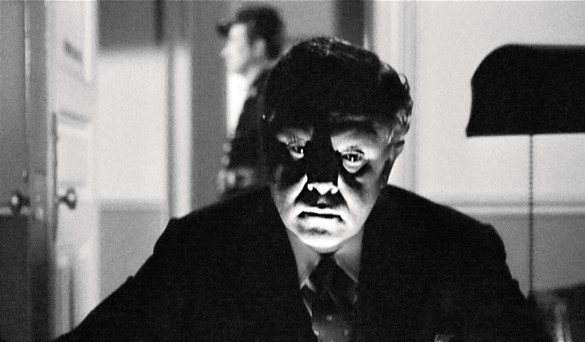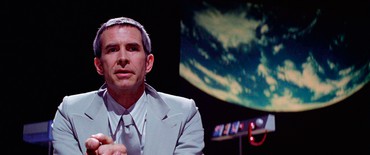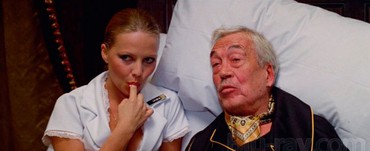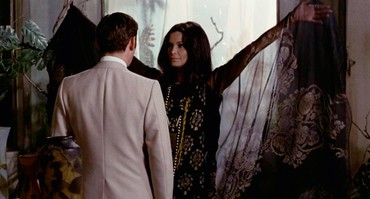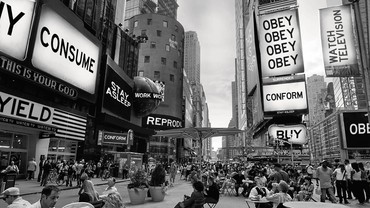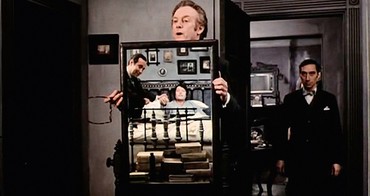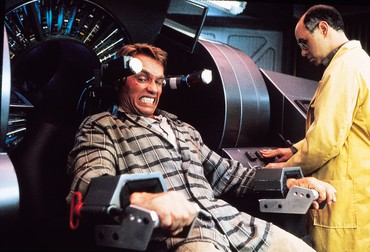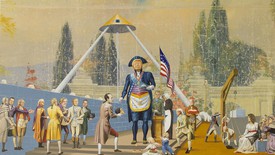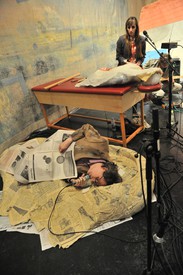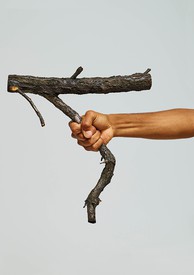
Natasha Stagg’s books Surveys and Sleeveless: Fashion, Media, Image, New York 2011–2019 were published by Semiotext(e). Her writing also appears in the books You Had to Be There: Rape Jokes, by Vanessa Place, Intersubjectivity, Volume 2, edited by Lou Cantor and Katherine Rochester, Excellences & Perfections, by Amalia Ulman, and The Present in Drag, edited by DIS, among others. Photo: Roeg Cohen
“I knock on this door, and I go in and it’s a nice suite; there’s a young woman there, half undressed; she has a trench coat, which she’s just taken off; there was money in the inside pockets of the trench coat; she has an open briefcase on the bed with money in it; she’s taking money out of her brassiere.” So says production designer Robert Boyle in Who Killed “Winter Kills”? (2003), a documentary short that accompanies a DVD reissue of Winter Kills (1979), a comedic fictionalized exploration of the assassination of John F. Kennedy. Boyle isn’t describing a scene from the feature, though: this exchange, he says, happened behind the scenes. “That’s how I got paid.”
“And then,” says director William Richert, “we found out somebody shot and killed [executive producer] Lenny Goldberg—somebody he owed money to; they blew his brains out; they handcuffed him to his bed.” Not mentioned in the documentary: another executive producer, Robert Sterling, was sentenced to forty years without parole for narcotics distribution and other charges.
Winter Kills (which Boyle has called the “most delightful” film he’s worked on) bobs and weaves around the unsolved murder of an American president named Kegan, pausing to focus on the interpersonal relationships that make conspiracies so difficult to predict or trace. Screening at Metrograph in collaboration with Gagosian this past October, it was one of six films curated and introduced live by artist and conspiracy-connoisseur Jim Shaw. The program included two of Hollywood’s best depictions of justified paranoia set in Earth’s market-driven, alien-run future, They Live (1988) and Total Recall (1990), as well as some deeper cuts.
In Investigation of a Citizen above Suspicion and Leo the Last (both 1970), a protagonist is painfully aware of his position within a corrupt, cushioned inner corridor, in the former as a murderous police chief, in the latter as heir to a dethroned royal family. Each can’t help but be curious about just how far the networks that protect them stretch. The spoiled but suspicious heir in Winter Kills (Jeff Bridges) follows clues that lead to ever more nefarious discoveries about his powerful relatives. In one horrifying aside, President Kegan’s father (John Huston) mentions that he is undergoing blood-replacement therapy: “I take it from the kids at Amherst. Got a deal with the Red Cross.”
Shaw has been thinking a lot about the proliferation of conspiracy theories in the past couple of years. He’ll watch any documentary about one, no matter how unprofessional, he told me before we entered the theater to watch So Dark the Night (1946). If copyright law didn’t matter, he added, he would have chosen some YouTube rabbit-hole discoveries for his series. “For me,” Shaw said, “and for anybody that’s entranced by conspiracy movies, by true crime podcasts, by endless depressing documentary series about horrible events that took place at some boys’ school sometime in the ’70s, it’s stimulating the frazzledrip in our brains.”
“Frazzledrip,” as far as I can tell, was coined by people at the website NewsPunch (formerly YourNewsWire). According to QAnon followers on social media, the term comes from the file title for Anthony Weiner’s personal footage of Huma Abedin and Hillary Clinton terrorizing a child before drinking her blood in a Satanic ritual. One surmises that it is slang for the release of adrenochrome, an excuse for torturing a virgin sacrifice these days: in a widely shared conspiracy theory, panic causes this chemical compound to be released into the youth’s blood, which consequently becomes the perfect elixir for evil energy-harvesters.
Conspiracy, or the dramatization of it, conjures another kind of energy. “There’s an aspect of conspiracy theory, and everything that engages people with, say, QAnon, that creates a sort of adrenochrome in your brain by stimulating it,” Shaw said. “It’s like frazzledrip is a frazzledrip. The idea of frazzledrip gets someone who believes in frazzledrip all excited in the same way that torturing children is supposed to bring about adrenochrome. . . . That’s kind of what goes on in the cinema.” Soon, the lights dimmed and the next movie rolled, opening with a sex scene that turns into a bloody murder.
Adrenochrome, by the way, is a real thing, and scientists have been interested in its properties for decades, without publishing much in the way of findings. Its name has been dropped in literature and song lyrics since the 1950s, mythologizing it into a rarefied drug found only in living humans. Aldous Huxley’s Doors of Perception (1954), Anthony Burgess’s Clockwork Orange (1962), and Hunter S. Thompson’s Fear and Loathing in Las Vegas (1971) all describe adrenochrome as a psychedelic. Rich people filling their veins with fresh blood to stay young, like the joke in Winter Kills, is real, too. According to a Los Angeles Times article from 2019 (“As age-obsessed billionaires turn to ‘vampire’ therapies, the FDA takes a stand”), the government recently issued a warning against the injection of young donors’ plasma. Older patients would pay $8,000 a liter, said one start-up that offered these injections.
Science-backed institutions have found no evidence that young blood, whether full of fear-induced chemicals or not, is energizing, mind altering, or age fighting. But many conspiracy theories posit that institutions have much to gain from spreading false information about such things. Either way, the news being reported from all sides is that there are in fact American sex cults entrapping young people to pacify the elite. And when, say, Jeffrey Epstein’s life and death are at least as sinister as any vampire fiction, the defining characteristics of a reliable narrator start to blur.
When Shaw was installing his three-story takeover of the New Museum, New York, Jim Shaw: The End is Here, in 2015, he found that he was missing a video component for The Hidden World, his massive collection of propaganda from “secret societies, evangelical and fundamentalist movements, new-age spiritualists, Scientologists, Freemasons, ultraconservatives, and all kinds of conspirators.” So, he wrote in an email after the screenings, “I looked for stuff on YouTube and found endless docs about the Masons, pedophile conspiracies, etc. Most had an English-accented narrator that I realized was a computer voice reading a script to give it ‘authority.’” This started yet another content collection: a list of conspiracy-themed movies, from film noir to “the various low-budget documentaries that helped me through [2020] and stimulated my dopamine receptors . . . usually featuring a narrator droning on about the Illuminati with cheap panning graphics.”
Shaw’s work tends to face far outward, seeking and hoarding alternative forms of truth and religion that would normally never enter New York art-world circles. In his collages and collections of media and marketing, messages contradict one another using similar languages, in turn muddying their individual initial intents. But in these wandering, decades-long surveys of fringe thinking, Shaw is looking inward, too.
Born in Midland, Michigan, Shaw graduated from the University of Michigan before getting an MFA from the California Institute of the Arts. Just out of school, he got a job doing sketches of “the dream of a god and prehistoric animals made from living ones” for Terrence Malick’s planned follow-up to Days of Heaven (1978). (The project was put on hold, then released several decades later, in 2011, as Tree of Life.) Other film and advertising jobs included “designing monsters for a [Roger] Corman Alien rip-off called Forbidden World [1982], a couple of months airbrushing on Tron [1982], a four-year stint at [Robert Abel and Associates] working on high-end FX commercials, various stints at DreamWorks doing the effects animation for The Hidden [1987], A Nightmare on Elm Street 4 [The Dream Master, 1988], and a scene in The Abyss [1989]; I designed the titles and alien fur and spaceships for Earth Girls Are Easy [1988], then there was a 3D CGI thrill ride for a Sanrio amusement park . . . ”
A Midwestern sensibility and a fascination with the theatrical are plainly felt in Shaw’s sprawling yet somehow humble art, which comes in the forms of scenic painting, video, installation, and other mediums. And his extensive experience of the mechanisms that animate so many runaway imaginations has not inured Shaw to their effects. In fact, ever since he’s been behind the scenes in the production of thrillers, simulations, arcade games, commercials, and cartoons, he’s only grown more fascinated with the extended lives of certain science fiction and horror scenes as they appear in countless paranoid hypotheses, especially since, as he said at the screening of Investigation of a Citizen above Suspicion, “conspiracy theories exist because conspiracies do.”
Meaning: power-hungry people who want to live forever do pull society’s strings; that these strings are so intertwined with everyday life means that they are indecipherable. Movies that metaphorize conspiracies like the ones in Shaw’s list stimulate in the same way a YouTube explainer does, frazzledripping down our washed brains as we attempt to determine truth from trope. Fleshed out with bouncy Ennio Morricone soundtracks, sexy actresses, and Franz Kafka quotes, these movies simplify complex themes in the style of the truth-revealing sunglasses in They Live. We see the curtain and what stands behind it, all while getting wrapped up in the excitement of falling down a rabbit hole. Then, leaving the theater, we might wonder: if that was all okayed by studios, commercial markets, and investors, how much of the story wasn’t?
As cynical as Winter Kills seems, for example, the making of the film was apparently as dark and tangled as its script, inadvertently proving some greater point about what happens when one attempts to reveal something seedy using the same systems behind such seediness. The story goes that the shoot was shut down multiple times because the crew were not getting paid by the production company, which had only ever made softcore Italian sexploitation before and had hired first-time director Richert based on the recommendation of the director Milos Forman’s agent. After the death of Goldberg, Richert (who was then dating one of the stars of Winter Kills, model Belinda Bauer) came up with a plan to finance the half-done bankrupt film: he took Bridges and Bauer to Germany and directed another movie with them, The American Success Company (1980), which somehow raised enough funds to get Winter Kills running again. To recap, a Germany-set movie about an American credit card company (“AmSucCo”) saved a movie made with dirty money about the American government’s endless plots to keep its citizens ignorant. And then Winter Kills (budget $6.5 million) bombed, making just over a million at the box office. But maybe that was because it was blacklisted for unpatriotic sentiments.
The movie was based on a book, and the book’s author, Richard Condon (who worked for decades in Hollywood before becoming a satirical novelist), later wrote a piece for Harper’s about life imitating art. There he described, in as much detail as he knew, the whole crazy tale of Winter Kills, including its inspiration. In 1963, after the American public learned that many groups and individuals had motives for murdering JFK, Condon writes, “Overnight, a belief in conspiracy came to be equated with raging paranoia. To believe in any conspiracy against the government was paranoid, the public was told again and again.” Richert told Condon that, when reading the book, he’d thought it “too far-fetched, too criminal, seditious, incendiary, poisonous in its rendering of the big time,” but that “since making the picture I’ve met all the types.”
When the star-studded film was finally released, it won ecstatic reviews but was pulled from theaters early and never widely distributed. Everyone had their own theory about why. “It was 1979,” writes Condon in 1983. “A presidential election was coming up. Avco, which was the parent company of Avco Embassy [distributor of Winter Kills], had revenues of $864,646,000 that year for its products and services, and these included important contracts with the US Departments of Labor, State, and Defense. It is tempting to speculate that Avco might have felt it expedient to please powerful political friends”—meaning the Kennedys, in particular Ted, who was campaigning for the US presidency—by killing Winter Kills.
Shaw told me to read the story of the making of this movie as itself a twisted conspiracy theory about the Kennedys and the American government at large. It is easy to see, when looking at any of his art, that he is interested in seeing stories from every angle, and his movie list is no different: there’s the controversial murder, the conspiracy surrounding it, the narratives spun out of hypothesizing, the suppression of such narratives, the stories of suppression, etc. So goes the endless stream of theorizing uploads online, which often use popular cinema to explain themselves, even when said theories claim that Hollywood is an evil agency.
Making connections, no matter how far-fetched, is intoxicating. We are taught to search for meaning in narrativization, and so we do, constantly scanning for revelation. Also on Shaw’s recommendation, I watched homemade video after homemade video, their slapdash, train-of-thought structures part of their allure. Some of these adrenochrome explainers, for example, are exciting to watch because through them we can witness adolescents trying to untangle their own mindsets from social conditioning. As I was inundated with wild theorizing in every direction, it all started to blend together, becoming a bigger story about what people—everyone, from the unassuming Midwest to the master manipulators in DC and Silicon Valley—do with guilt.
Investigation of a Citizen above Suspicion centers on a detective (Gian Maria Volonté) who commits murder but is naturally not considered a suspect. Knowing what he does about his department, he is intentionally sloppy about hiding clues when he commits the crime. His prints will soon be all over the scene anyway once he is called in to investigate. Eventually, he admits to himself that he has waffled between wanting to get away with the crime, to prove the existence of absolute authority, and wanting to be caught. He breaks down, believing that everyone exercising power over citizens, such as police and politicians, internalizes this dichotomy, and that they cling to a kind of sadomasochism. His desire both to control and to be controlled is a human desire just as all desires are human. His addiction to danger produces diminishing returns, so he resorts to killing a woman and later torturing a man, getting a thrill from the suffering of others at his hands—suffering for its own sake.
In QAnon thinking, the suffering of the innocent has a purpose, and the greater the suffering, the more innocent the sufferer, the greater the outcome for the offender. I asked Shaw what he thought of the obsession with tortured kids that binds so many alternative worldviews together. Based on a few examples of acquaintances, friends, and famous people, Shaw hypothesized that “if your emotions are severely stunted, you might need the slaughter of the innocents just in order to get any emotion.” (Shaw believes that he himself likely has Asperger syndrome.) “Abortion horror,” he says, “has been a unifying issue for the conservative Christian Right for five decades, and I think the whole Illuminati baby-blood-drinking thing just goes along with that mindset, as well as the need to think of one’s enemies as the most horrifying entities imaginable. The fact that there are several organized groups like the Catholic Church, the Boy Scouts, smaller cabals like Jeffrey Epstein’s or Cyril Smith and his pals, that allow, overlook, or use pedophilia for influence, makes fantasy conspiracies like QAnon seem possible, and being out of work or holed up because of COVID (or both) for long periods of time and plenty of time to kill on the Internet while algorithms feed you the most alarming information? It’s a perfect storm.”
